How We Started an Urban Food Tree Project
Ever since we first moved to our suburb 18 months ago, I had my eye on the rather sad looking patch of land at the corner of the street. Despite the weeds and bare nothingness (excluding the few surviving melaleuca trees around the edge), all I could see was the epic potential.
Wouldn’t it be great if we could turn this barren, weedy patch of land into a thriving community orchard?
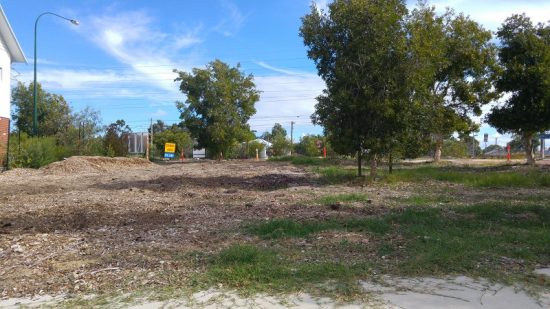
My neighbours, and one in particular, shared my enthusiasm and vision. Almost as soon as we moved in, the conversation began. At the start of this year, the actual work began, to turn the conversation into reality.
The Initial Idea: Creating a Food Tree Project
Rather than planting an orchard where the goal is to maximise production, we wanted a balance. Growing fruit trees alongside natives and groundcovers creates a more aesthetically pleasing, biodiverse and dynamic ecosystem that will be more interesting to walk through, creates more learning opportunities and is more resilient to pests.
The name “Food Tree Project” rather than an “Urban Orchard” reflects that our goals were broader than simply planting fruit-bearing trees and producing food. The permaculture concept of “Food Forest” didn’t really fit either, because although I followed permaculture principles in the designing, there are too many human inputs to be a true permaculture food forest.
Food Tree Project felt best.
Our Vision:
Community: to provide a space for collaboration, learning, volunteering and sharing; to encourage residents to learn more about growing food and have access to locally grown fruit; and create an attractive and sheltered resting spot close to the train station.
Environment: to increase tree coverage, canopy cover and greenery; to improve the streetscape close to the train station; and to increase biodiversity and provide habitat for birds.
The Plan:
The plan was to plant around 40 fruit trees of varying species on the unused space on the corner of two streets in our suburb, with wide pathways between the trees to allow and encourage public access for community members to see the trees and learn about them.
We also planned to plant native species on the border to encourage biodiversity, and interplant nitrogen-fixing acacias and other ground covers to create a green space between the trees.
The property next to the block has a bore, we are extending the reticulation so that the site will have water access in summer (this is essential in Perth – no water means no trees).
Goals of the Food Tree Project:
There are a number of goals we hope to achieve with this project.
- Create a welcoming and shady community space by planting trees, and to provide access for residents to locally grown fruit.
- Provide learning opportunities for interested residents on growing their own food and looking after fruit trees, and to provide volunteering opportunities.
- To provide a demonstration project and framework that other volunteer groups can take to their local council to plant more trees on underutilised spaces in their urban environment.
The First Step: Getting Council Approval
The scariest step is probably asking for permission. Have you ever heard the expression “ask for forgiveness, not permission?” If we asked the council for permission and they said no, it would be hard to go ahead and do it anyway.
Should we ask for permission, or just do it and hope they didn’t mind?
However, we want this project to be an example of what can be done, a demonstration project to encourage others to approach their councils to plant on underutilized spaces. That meant going through the official channels. So we put together our vision and arranged to meet a council member on the site to discuss our plans.
We met on the site and talked through our ideas. We asked what restrictions they had (for example, banned or unwanted species) and were willing to listen to any needs that they had. I’d recommend meeting in person rather than chatting via email. It’s so much easier to connect with someone when you are face-to-face.
We agreed to put together a plan of the site detailing the trees to formalise the project. I took a screenshot of the Google arial view of the block, then pasted that into Powerpoint. I drew lines over the roads, paths and boundaries, and put cloud shapes over the trees, then deleted the photograph to keep the outline.
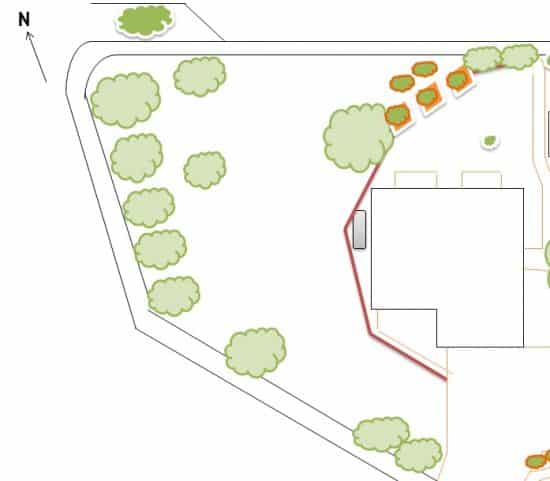
The initial outline drawn using Google Arial View and Powerpoint…
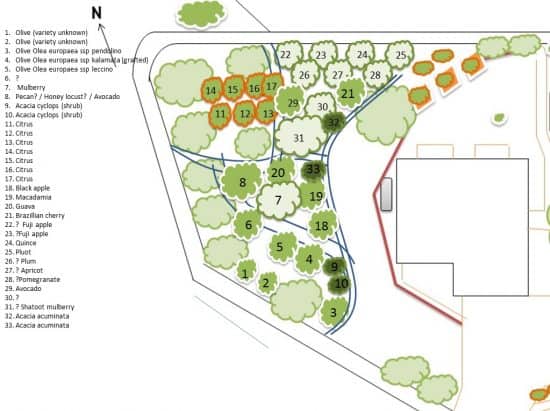
…and one of the working drafts (of which there were several!)
On one hand, we were lucky that the council were so supportive. But on the other hand, it wasn’t really luck. My co-conspirator neighbour had been working with the council on a community sump revegetation project for a couple of years prior to this, and had been able to build the relationship with the people there. He had demonstrated his ability to listen, to work together with them to resolve disputes, and show responsibility.
Although it felt like we got approval very quickly, my neighbour joked that the work actually began in 2012. In truth, it probably did.
Step 2: Formalising The Project
As well as submitting a plan for the tree planting, we also had to submit a pest control plan detailing how we would manage the site and deal with pest issues. For this, I referred to the council website and Department of Agriculture website to find out current recommended procedures.
Initially, the plan was to lease the site from the council. This would have required insurance, which we were planning to get through the local community garden (of which both my neighbour and I are members). There would have been a small annual cost for this.
In the end, the plans changed and there is no lease: the land remains under responsibility of the council. Whilst this may seem less secure, there are advantages. The site actually had a road running through it prior to 1990 before the road layouts were changed, and there was road base right through the land. The council came with a bobcat to dig out the road base, which might not have happened had there been a lease in place.
Funding Opportunities
Needing funds to purchase the trees and the reticulation, we approached the local football team (the West Coast Eagles). They have just moved to our suburb and are constructing a new training ground and stadium, and in the process angered the community greatly by chopping down 100 mature native trees.
As they emphasize their commitment to community in their media releases we thought it might be a project they would like to support.
Initially they seemed keen to sponsor our trees, but over time it became apparent that they had ulterior motives. The council had stipulated that all trees removed whilst building the training grounds must be replaced and maintained, and the Eagles were hoping that they could fund our trees as a cost cutting measure. (Funding a few $30 fruit trees would have saved them the cost of sourcing, planting and maintaining mature native trees.)
Without going into details, the Eagles were not transparent with us about this. When we realised (several months later) that, rather than supporting our project because they saw the value in investing in community, they were trying to get out of their responsibilities (clearly a small citrus tree is no replacement for a large gum tree), we decided not to pursue this further.
All the messing around meant time was ticking. It was now the start of winter and we urgently needed to plant the trees if they were to survive the summer.
Preparing the Site, Tree Purchasing and Getting the Community On Board
In short, we didn’t receive funding, and decided we would have to buy the trees, reticulation and soil amendments ourselves. We’d decided that the upcoming weekend would be perfect tree planting weather, and we began sourcing trees. My neighbour purchased seven citrus trees and I purchased another six trees, and we began setting the foundations for the project.
We planted the first few trees ourselves to get an idea of time and how best to do it all.
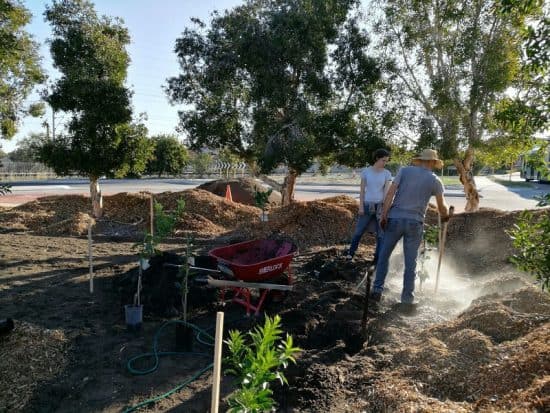
Next we put it out on the Buy Nothing Group that we were beginning a Food Tree Project in the area, and would anyone like to come and help us weed and plant?
And something wonderful happened.
People said yes, but many also asked us if they could donate a tree, or provide funding to purchase a tree. We hadn’t asked for money, but it was so humbling (and immensely appreciated) that our neighbours wanted to contribute financially.
One tree is not expensive (the costs varied from $20 to $70 depending on the species) but 40 trees adds up. Not to mention the reticulation costs, which my neighbour funded himself. When there’s a whole community on board, that changes things considerably. After our initial tree purchases, the others were paid for by the community.
It also showed us that people valued what we were doing, and wanted to be a part of it. (Thanks to Jayne, Deb, Miranda, Kath, Marisa, Lindi, Kate, Lana and Toni for your contributions.)

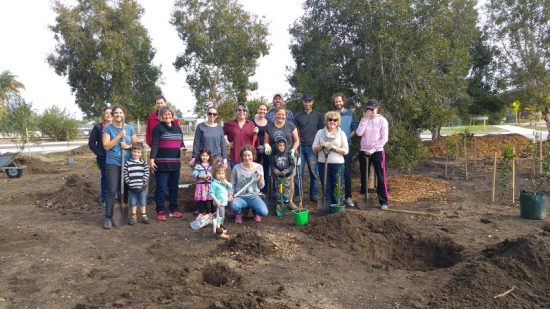
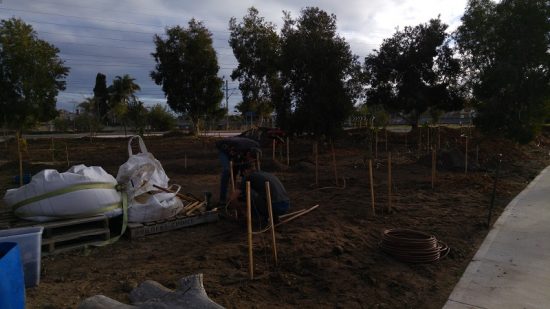
Just as importantly, people came to our busy bees. We weeded the rest of the site, dug holes, spread clay and compost and planted trees. Then we installed reticulation, and mulched the entire site. What could have taken us months was finished in a three weekends.
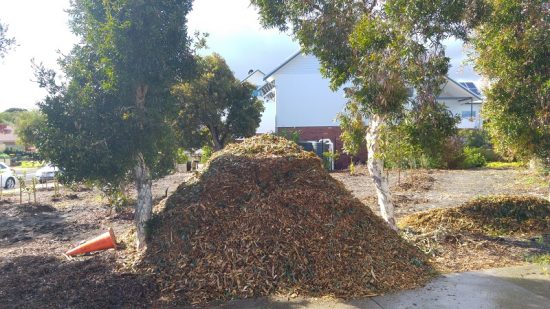
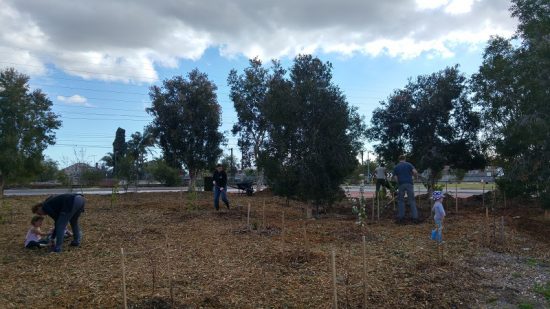
We now have most of the trees planted.
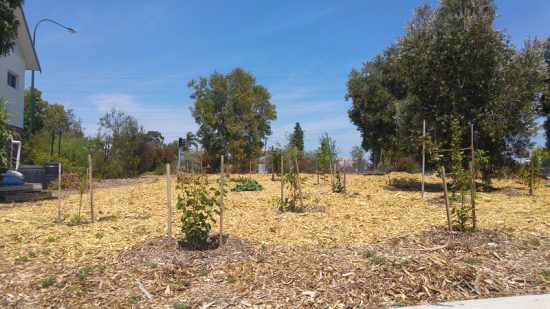
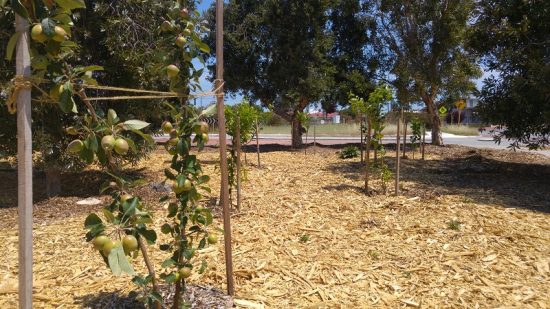
(If you’d like to know more about the project, I recorded a 20 minute video with some details of how we got the project going, and also a walk through of the site and the different trees that we have planted. You’ll find it on my Patreon page.)
What’s Next for the Urban Food Tree Project
Our biggest job is to ensure that the trees survive their first year in the hot Perth summer. With the reticulation in place, this shouldn’t be a big job, but it is a job nonetheless.
One thing we are doing now is establishing a community composting bank. We’ve put two huge compost bins on the site and plan to add to this as we find more suitable bins on Gumtree. If we can get all of our neighbours dropping good scraps off, we will have a rich supply of compost to feed the trees with. Plus it is another way to involve our neighbours with the project.
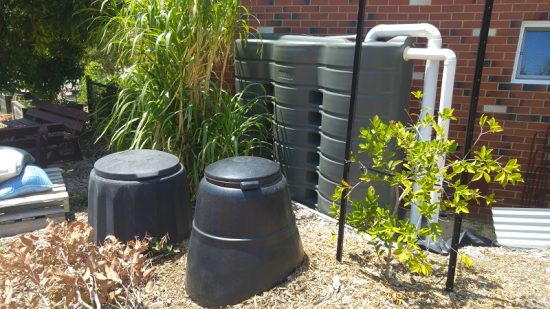
When autumn comes round I’m keen to work on the shrub layer and groundcover. Having sunk a lot into the project this year, we didn’t have the funds or the time to do this before now, and summer is not the time to start. We are keen to plant herbs and natives, and as the canopy layer grows these plants will have more chance of success.
At the moment the site looks a little barren, but by next year it should be completely transformed.
Now I’d love to hear from you! There’s so much more I could share about the project, so do you have any questions? Is there anything you’d like me to explain in more detail? Do you have any tips or suggestions for me, or experience with projects of your own? Please tell me your thoughts in the comments below :)
[leadpages_leadbox leadbox_id=1429a0746639c5] [/leadpages_leadbox]
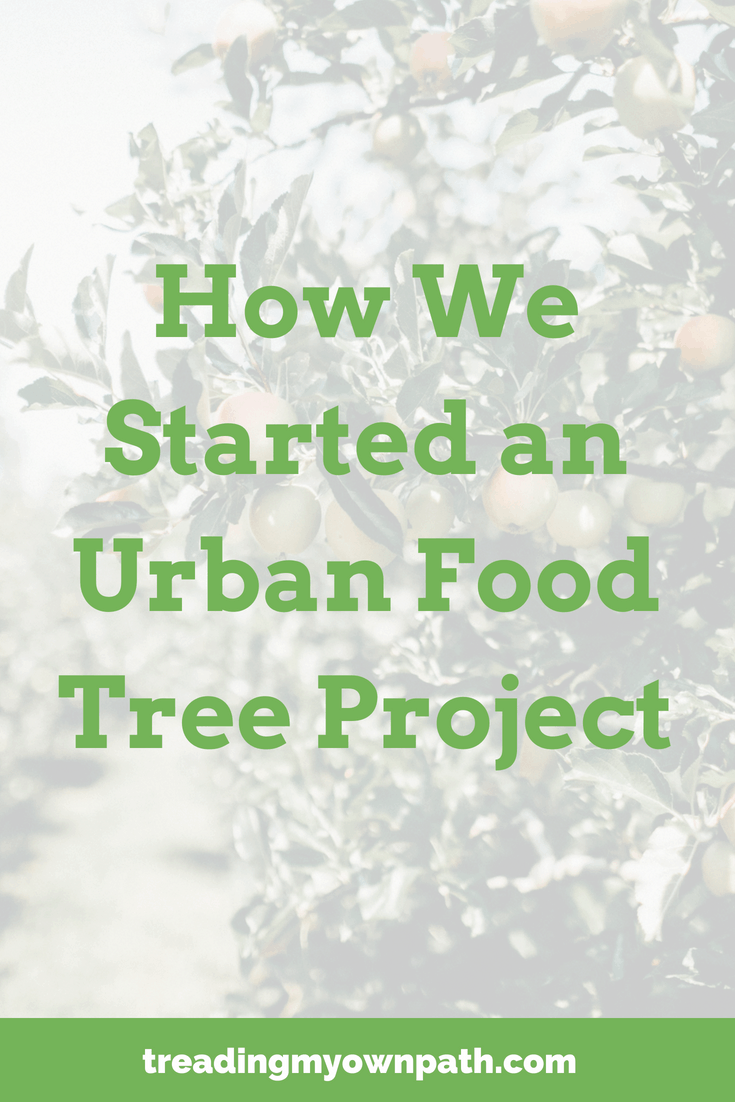

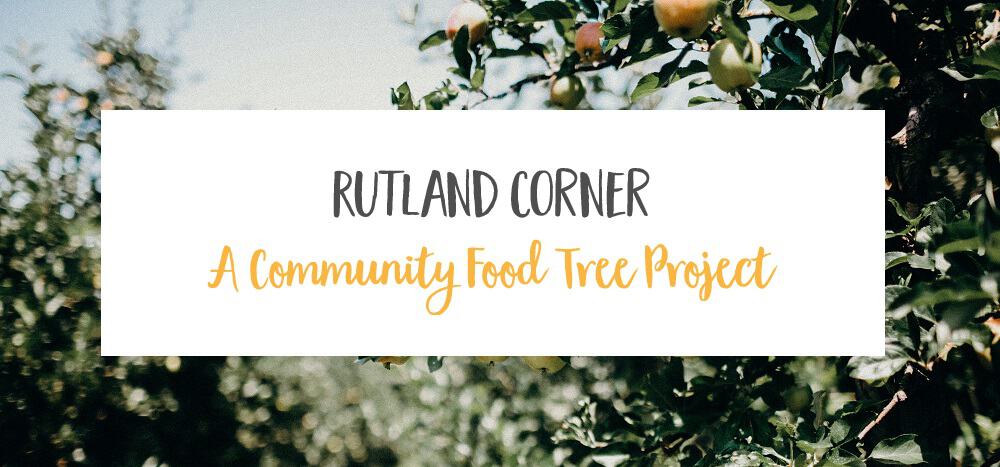




Amazing!
Thanks Rebekah :)
Love this initiative! I hope it will be a great base for others to base similar projects on! Good on you all!
Thanks Gin. That is exactly my hope – may there be many more projects like this! :)
I would SO love to do this. One day!!!!!!!
One day indeed!
Well done Lindsay. It’s great when a community comes together. I’m sure more will get on board when the trees start fruiting. :)
Thanks Darren. Oh I am sure they will! When I took this photos I managed to snaffle three black mulberries and two white ones, so I doubt it will be much longer ;)
Are should able to share what shire/council this was done in? I’m in Perth, and have pondered approaching my local shire about a community garden in a barren run down location. I’ve learnt a lot from your post about how and where to start these discussions a
Hi Jo, of course. I am in the Town of Victoria Park :)
Can I ask whether you applied for the funding or grant as an individual? Or as part of a organisation, my shire seems to have constraints for individuals, so wanting to research options.
The only funding we have been seeking actively was from the Eagles. And that is actually still ongoing.
So far the funding has been coming from a mix of different parties: We have had great support from Town Of VicPark in the form of labour and machines. They have been a great help to clear the road base that was there before and to truck in compost to improve the soil (thanks also to Mindarie Regional Council).
Some people that have been helping to plant the trees and live in the area have adopted some of the trees.
We had private funding for: rent of rotary hoes (to clear couch and loosen up soil), clay, biochar, fruittrees, retic, compost bins. Mulch has been delivered mostly for free (there are a few outlets).
Depending on where you choose your site to start a project like this, by far the biggest job could be the clearing of couch and to stay on top of it before any fruit trees get planted/established. That is of course if you want to do it chemical free…
There’s so much I could say about it all Helmuth I probably need three posts! I’ll probably add some more at some point about the design and all of those things. And of course you should be acknowledged as the biggest “private donor”. If it had been up to my bank account we’d probably be hand watering every day all summer! :/ It’s been a fun project to do. Thanks for all your hard work!
Hi Joanne, as Helmuth says, we contacted the Eagles as an unincorporated organisation, but didn’t contact anyone else for funding.
What Helmuth refers to as “private funding” is the contributions that our neighbours have made for trees and towards the reticulation, but honestly, Helmuth and his wife funded a lot of this themselves from their own pocket.
We pitched at the Vic Park Soup night for a grant, but lost by three votes. That would have funded the rest of the trees, the compost bins, groundcover / shrub species and some ongoing costs – exclusion bags for fruit etc. Now our expectation is that we will have to pay for that ourselves, which is why we will wait until next year.
Wow! Great project.
The best kind, Mel! ;)
I may be a sap but I sniffled a bit at seeing your community work together on such a beneficial project! Thanks for the inspiring post and all the best as you continue. :-)
That made me laugh Danielle! It is such a great project. Just thinking about it makes me smile. Thnks for the best wishes – can’t wait to share the pics in a year or so, so that you can see the progress! :)
This is a very inspiring project! Since moving out of my parents place (ten years ago now) I’ve always lived in cities with a huge population density, so nothing is left barren for very long because it is too costly. But I have always thought that community gardens like this are an amazing way of not just fostering a sense of community but also making a neighbourhood much more liveable. It would be great if, in cities like mine, councils made it a priority to create space for such things. I hope the trees do great through the summer!
A second thought: we used to live opposite an apple orchard surrounded by blackberry bushes. The whole neighbourhood would enjoy the apples and blackberries. Until one year, and every year after that, a couple of men decided to pick all the apples and blackberries to sell them at markets elsewhere in the country, leaving nothing for the community that took care of the orchard. It may be worth thinking about how you will handle it when someone breaks the social contract so blatantly. (in this case we could do nothing because the orchard was technically private property of a lady with dementia who would not press charges)
This is amazing! Great work. I’d love to see it and help out if needed. There must be so many disused areas where this could work. Well done on taking the initiative.
Thanks Sarah :) If you’re local there’s a Rutland Corner Facebook group that you are welcome to join, we will post the upcoming busy bees and other related stuff there :)
Well done Lyndsay and friends. This is such a great initiative
Thank you Maureen :)
What a great project. I wish you all the best. I love the tie-in with community compost project too. I don’t know if “worm juice” from a worm farm is any good for fruit trees but if so, perhaps volunteers could donate their excess worm juice fertiliser if they have a worm farm at home??
Thanks Julie. That’s a great idea :)
Great project, Lindsay! You never stop to inspire us. Thank you.
Thanks Annemieke and team :)
Would planting potatoes be a good idea? As they grow quickly and easily and people reap the benefits of eating from their efforts. Well done and good luck
The soil is pretty sandy so it would require a lot of inputs, not to mention summer is the worst time of year to grow potatoes. Sweet potatoes, however ;) We have planted some, but hopefully I can COVER the place in them! Yum!
What an amazing effort and how the community came and supported you with trees and donations warms the heart. This is an inspiring read, and I hope more comm7nities climb on board with this idea and our local Councils support the initiative it would be very disheartening if the Councils could not find ways to support these great ideas,concepts and give help and direction where needed.
Thanks for sharing this excellent project.
I currently work in a Local Govt role supervising street tree, urban forest and verge gardens, would like to hear more about this project and potentially assist with any others. Personally keen to see food and utility plants ( trees) in use in urban areas, promote planning-level permaculture design and multi-function green space in urban areas, developing urban forest and orchard systems etc.
Regards Gwyn Hitchin Palmyra
Hi, is there an updated post on the gardens progress? Also how do you manage watering costs, does your neighbour pay all the costs of water? Do the council subsidise any of it? Curious as I’d love to start one where we are, but the ground is very rocky, I was wondering if the clay spike irrigation from buckets would work, was this an option you discussed and have any advice on? Thanks, love the community involvement, great effort